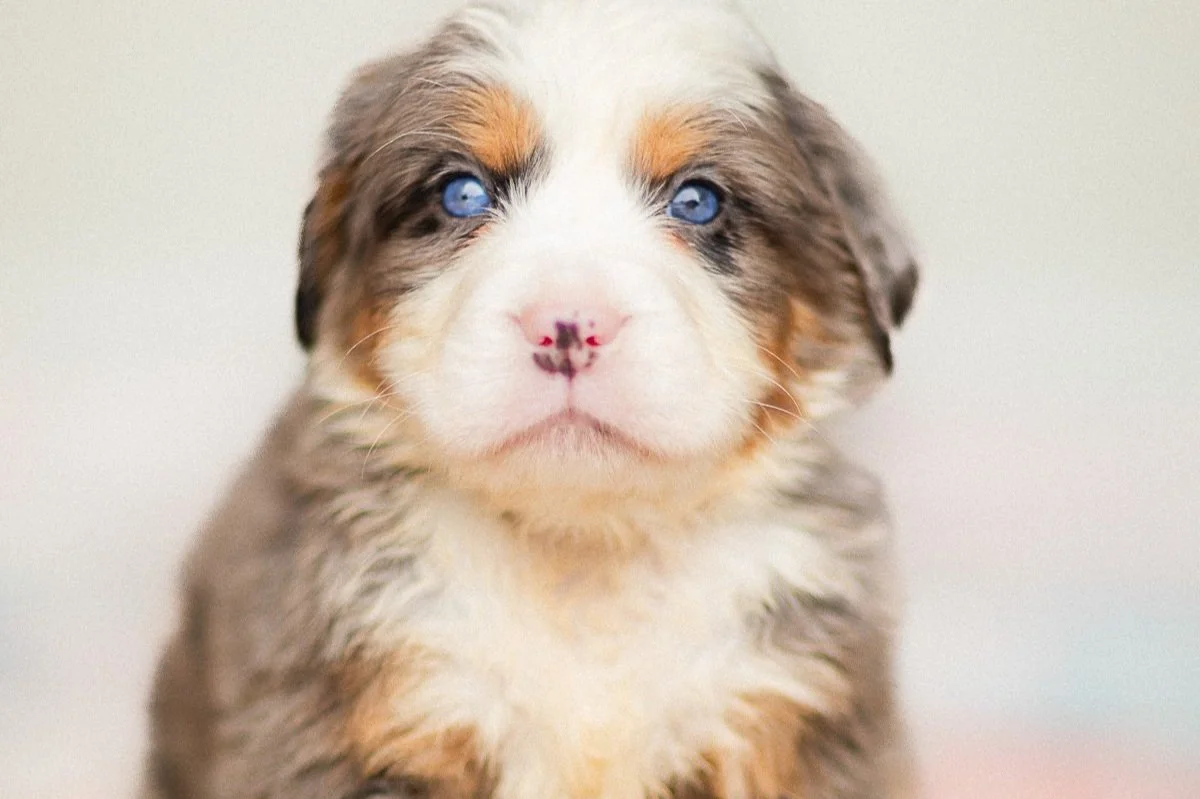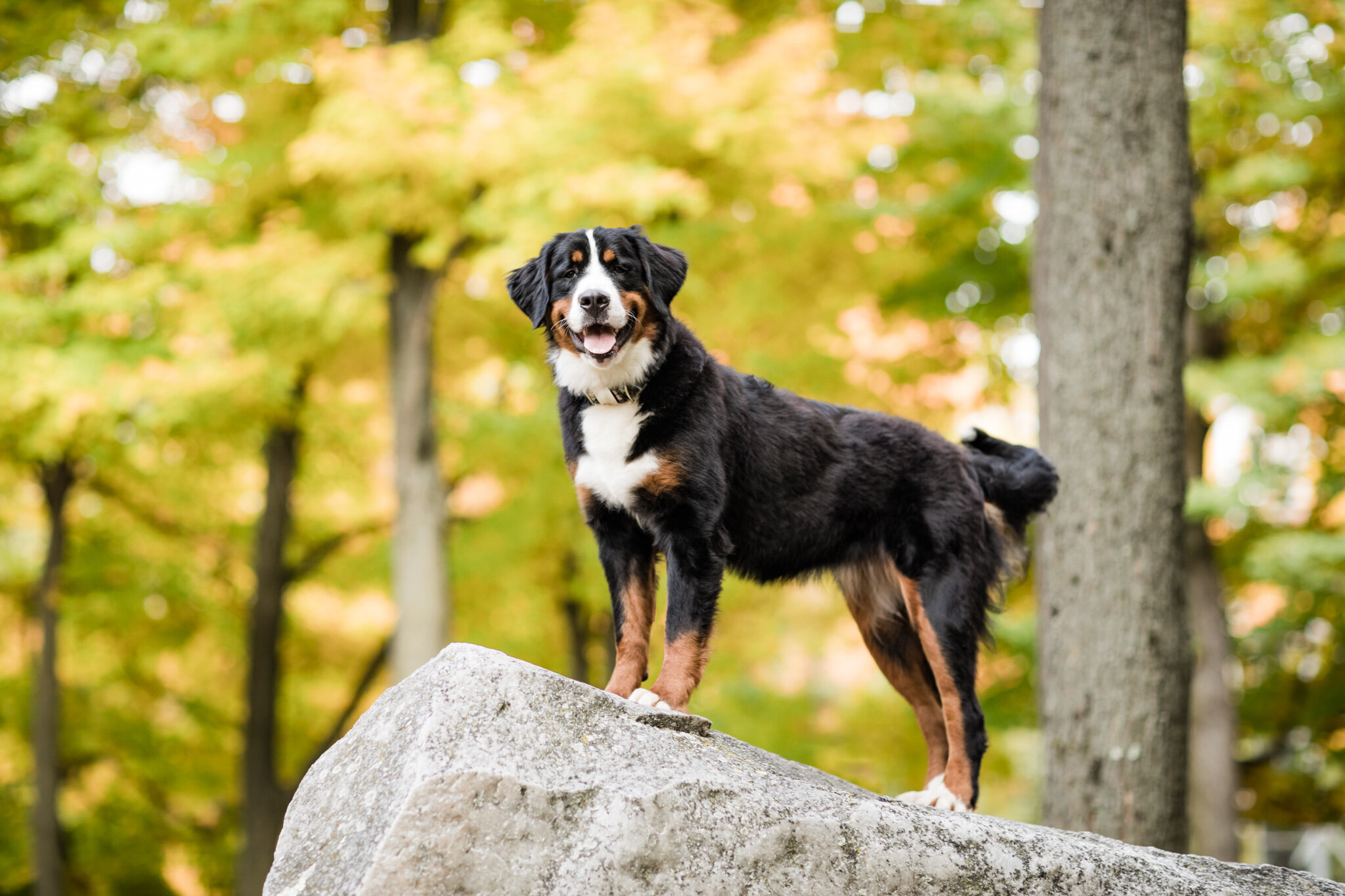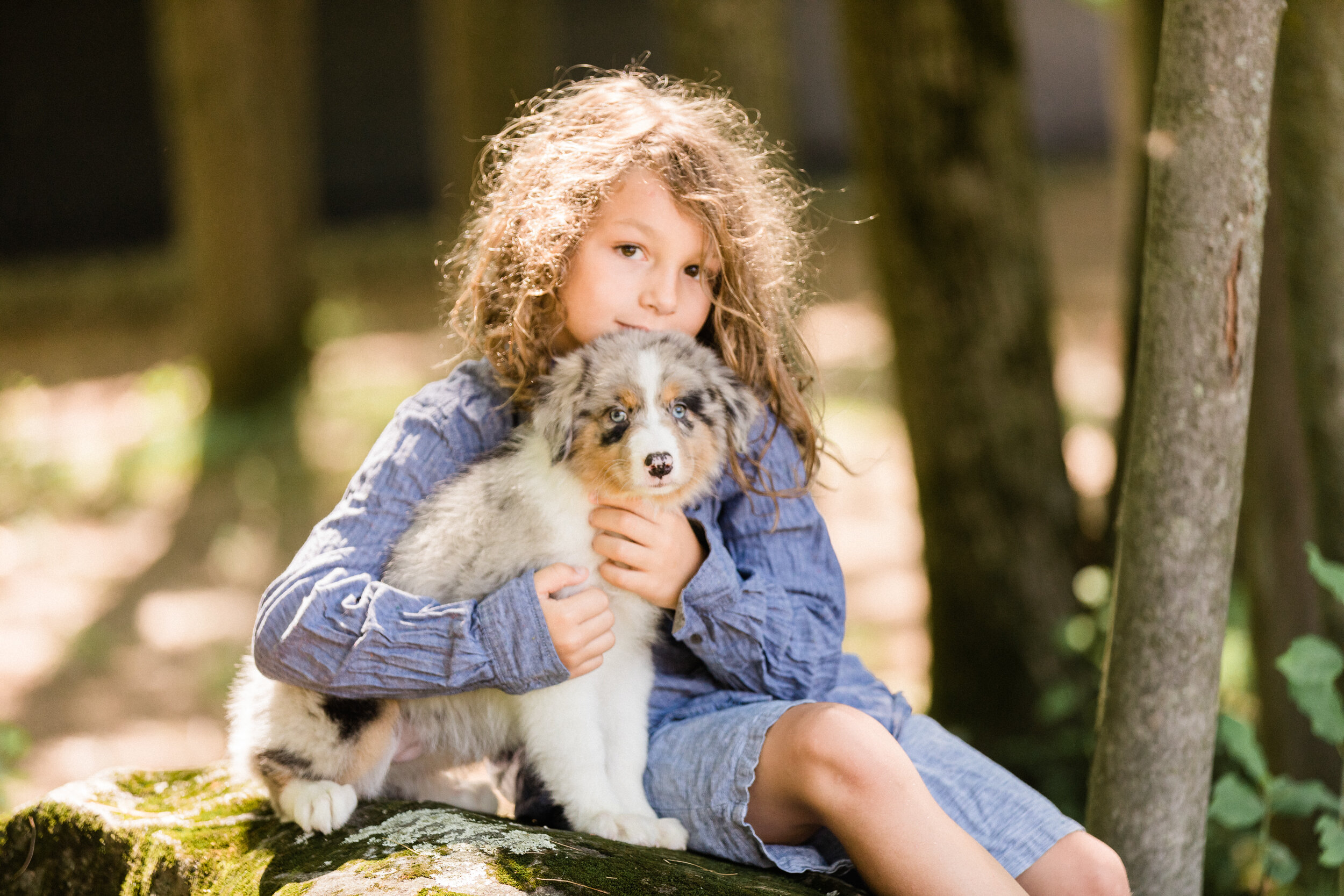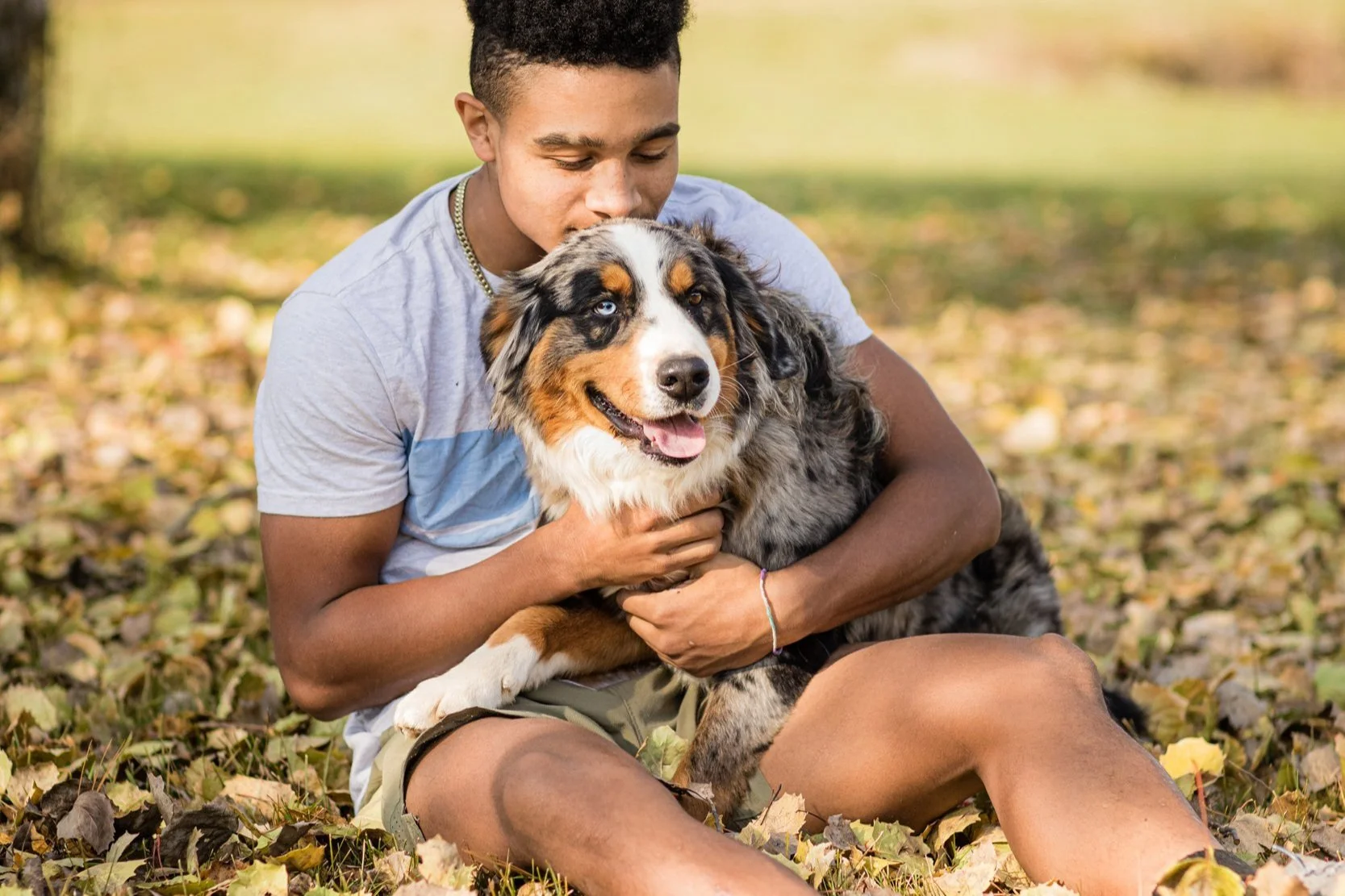How Designer Breeders Are Reducing COI for Healthier Dogs – The Tale of Bernese Mountain Dogs and Marie Antoinette
75% Bernese 25% Aussie Puppy
When we think of royalty, images of opulence, grandeur, and refined lineage spring to mind. Yet, beneath the polished surface lies a complex web of genetics that, interestingly, connects the noble Bernese Mountain Dog to one of history’s most famed figures—Marie Antoinette. Just as the Habsburg dynasty faced challenges due to inbreeding, the Bernese Mountain Dog grapples with its own genetic intricacies. Let's unravel this connection and explore the implications for breeders and dog enthusiasts seeking healthier lineage for their beloved Bernese companions.
The Genetic Dance of Royalty and Canines
Marie Antoinette, born Maria Antonia, had the highest coefficient of inbreeding within the Habsburg lineage, at an astonishing 30.53%. Fast forward to the world of canine genetics, and we observe a parallel in the Bernese Mountain Dog. The average inbreeding coefficient for these dogs sits at an alarming 35%, echoing the genetic closeness seen in Marie Antoinette’s lineage.
Understanding the Coefficient of Inbreeding (COI)
The COI is a vital genetic metric indicating the likelihood of inheriting identical alleles from each parent. For Bernese Mountain Dogs, a COI of 27% is significantly high, as responsible breeding practices typically aim for levels below 10%. Such elevated inbreeding levels can lead to a range of health concerns, compromising the vitality of these majestic dogs.
Feta
The Health Implications of Inbreeding
The ramifications of a high COI in Bernese Mountain Dogs are profound. The lack of genetic diversity often results in:
Reduced Fertility: Breeding success diminishes, with fewer puppies being born and surviving.
Increased Genetic Disorders: Higher susceptibility to hereditary health issues like hip dysplasia and certain cancers.
Lower Birth Rates and Longevity: Genetic health problems can impair reproductive success and shorten lifespans, akin to the impact observed in highly inbred human lineages.
Compromised Immune Function: Increased vulnerability to diseases, a consequence of diminished immune responses.
Impaired Growth and Development: Slower growth rates in puppies compared to those with greater genetic diversity.
This genetic vulnerability underscores the necessity for conscientious breeding practices that prioritize health over pedigree.
Breeding Beyond Tradition
For breeders committed to nurturing healthy Bernese Mountain Dogs, genetic testing and thoughtful breeding strategies are pivotal. By utilizing advancements in DNA technology and leveraging pedigree analysis, breeders can make informed decisions that foster genetic diversity. The goal? To lower COIs, thereby promoting a robust lineage that maintains the breed's beloved characteristics while enhancing their overall health and longevity.
Bernese Mountain Dog Puppy at 9 Weeks Old
Strategies for Healthier Breeding
Comprehensive Genetic Testing: Utilize DNA analysis to understand genetic markers and employ them in breeding decisions.
Broaden the Gene Pool: Introduce new bloodlines to minimize inbreeding and enhance genetic diversity.
Educational Initiatives: Participate in forums and workshops to stay informed about the latest genetic insights and breeding strategies.
Collaborative Efforts: Work with other breeders and geneticists to share knowledge and resources, striving towards a common goal of healthier Bernese Mountain Dogs.
BernGarde is a dedicated resource for Bernese Mountain Dog enthusiasts and breeders, focusing on promoting the health and well-being of the breed. The organization provides a comprehensive database that tracks the lineage, health, and genetic diversity of Bernese Mountain Dogs, enabling informed breeding decisions. Its primary goal is to reduce hereditary health issues within the breed by encouraging responsible breeding and sharing vital health information. BernGarde also provides resources and guidelines for breeders and aims to create a healthier future for Bernese Mountain Dogs while celebrating the breed's unique characteristics.
US History of Bernese Mountain Dogs Health and Longevity
The history of Bernese Mountain Dogs in the U.S. began in the 1920s. The American Kennel Club (AKC) officially recognized the breed in 1937, paving the way for their participation in conformation competitions. Following World War II, they became popular as family pets and working dogs.
In 1973, the Bernese Mountain Dog Club of America (BMDCA) was established to promote responsible breeding and education about the breed. There has been increasing emphasis on the health of Bernese Mountain Dogs, with clubs collaborating on genetic research to address common health issues.
A study found that neoplasia is a significant health concern in Bernese Mountain Dogs, with a high coefficient of inbreeding (COI) likely contributing to this issue. This breed has a genetic predisposition to certain tumors, and environmental factors may also play a role. Addressing the high COI through responsible breeding practices and ongoing research is essential to improve their overall health and longevity.
Understanding Inbreeding in Dogs
Full Sibling COI = 25%: Indicates a very close genetic relationship, as siblings share a substantial portion of their genes.
Parent-Offspring COI = 25%: This is expected since an offspring inherits half of its genes from each parent.
Half Sibling COI = 12.5%: Suggests a moderate level of relatedness, common in dogs sharing one parent.
Uncle-Niece COI = 12.5%: Similar to half-siblings, indicating a closer genetic link than distant relatives.
First Cousins COI = 6.25%: This is a lower level of relatedness, more acceptable for maintaining genetic diversity.
In the United States, many states prohibit marriage between first cousins due to concerns about potential genetic risks associated with inbreeding. However, when it comes to dog breeding, the practice is often more lenient. Inbreeding coefficients (COI) provide insight into the genetic relatedness of dogs. For example, full siblings and parent-offspring pairings have a COI of 25%, indicating a very close genetic relationship. Half-siblings and uncle-niece pairings each have a COI of 12.5%, showing moderate relatedness. In contrast, first cousins have a COI of only 6.25%, which is generally considered acceptable for maintaining genetic diversity in dogs. This disparity raises important questions about our understanding of inbreeding and genetic health across species, highlighting the need for responsible breeding practices that prioritize the welfare of animals.
Bernese Aussie Mix Puppies
What is COI?
The COI measures the probability that two alleles at a given locus are identical by descent from a common ancestor. Inbreeding increases the likelihood that both alleles in an individual are identical, leading to homozygosity.
Why is Homozygosity a Concern?
Loss of Vigor: Inbreeding results in more homozygous regions in the genome, leading to a loss of genetic diversity, which is critical for adaptability, reproduction, and resistance to disease.
Increased Risk of Genetic Disorders: When recessive deleterious alleles become homozygous, they can manifest as genetic disorders, reducing fertility, immune function, and lifespan.
Population Vulnerability: Populations with low genetic diversity are more vulnerable to environmental changes and disease outbreaks because they lack the variety of alleles that could confer resistance.
COI Thresholds
0% COI: This would occur in a population with no relatedness between breeding animals, common in wild populations with large gene pools.
<5% COI: Breeders often aim to keep inbreeding levels this low to avoid a significant loss of genetic diversity.
5-10% COI: Many breeders use this range as a threshold for acceptable levels of inbreeding. However, the impact of going beyond this threshold (e.g., 12% or higher) increases the risks of inbreeding depression, genetic diseases, and lower overall fitness.
25% COI: This is the level associated with full-sibling or parent-offspring crosses, considered highly risky due to the significant loss of genetic variation and increased likelihood of genetic disorders.
Nature Favors Heterozygosity
Natural populations tend to maintain low COIs (in the very low single digits) because heterozygosity promotes adaptability and resilience. For example, allelic diversity in a wild population helps ensure that individuals can respond differently to challenges, such as infections or environmental changes. A diverse gene pool allows some individuals to survive and reproduce even when others don’t.
Wild vs. Domestic Animals
The comparison of wolf and German Shepherd dog genomes shows the differences between wild and domestic populations. Wolves have low levels of homozygosity, while German Shepherds have significantly more areas of homozygosity (shown by dark blue in the chromosomes). This highlights the importance of keeping genetic diversity. Wild populations naturally control inbreeding through migration and bringing in new individuals. Domestic animals are at a higher risk of inbreeding due to controlled breeding practices.
Inbreeding and its effects on health, longevity, and reproductive success are well-documented across species. The data for humans and dogs show the complex risks involved. When thinking about a "safe" level of inbreeding, any level introduces some risk, but the severity of negative outcomes increases with higher inbreeding coefficients (COI).
From the examples provided:
Longevity: In humans, survival rates plummet when inbreeding levels exceed 6%. Similarly, in dogs, a COI above 6% significantly reduces lifespan, with dramatic reductions noted as inbreeding increases further.
Reproduction: Increased COI leads to smaller litter sizes and reduced fertility in dogs. A COI of 30%, common in some breeds, can reduce litter size by half, limiting breeding success and the potential for selecting top-quality offspring.
Disease Prevalence: Both humans and dogs face increased risks of genetic disorders, cancers, and other diseases as COI rises. While carriers of genetic disorders might not show symptoms, inbreeding increases the likelihood of producing offspring with homozygous recessive mutations, thus expressing genetic diseases.
Given this data, even though the effects of inbreeding may not be immediately catastrophic at lower COI levels, the linear nature of inbreeding depression suggests that no level of inbreeding is truly "safe". The closer you approach 0% COI, the lower the risk of negative outcomes.
However, given the practicalities of breeding, a threshold below which the risks might be manageable could be defined—keeping COI under 6% appears to mitigate the worst effects, based on lifespan and reproductive success data. This doesn't eliminate risk but may help balance genetic diversity with other breeding goals.
For breeders, using genetic testing to avoid stacking recessive mutations, along with efforts to reduce COI across generations, can help manage inbreeding risks and improve the overall fitness and health of the animals.
Keep it low
While lower is better, the "safe" level of inbreeding depends on the balance between maintaining the characteristics of the breed and preserving genetic diversity. It is generally recommended to keep the COI as low as possible (below 5% if feasible). However, breeders should avoid COIs exceeding 10%, as this can lead to inbreeding depression and health problems. In wild populations, inbreeding tends to remain minimal, as heterozygosity is key to survival.
Maintaining genetic diversity through careful selection and avoiding repeated close crosses is crucial to ensuring the health and longevity of a breed.
Bernese Mountain Dog puppy on Chair
A Call to Action for Breeders
Breeding dogs is as much an art as it is a science—aiming for the finest balance of aesthetics, temperament, and health. The legacy of Marie Antoinette serves as a poignant reminder of the perils of inbreeding and the imperative to pursue healthier genetic pathways.
By prioritizing responsible breeding practices, breeders can honor the noble heritage of the Bernese Mountain Dog while ensuring a vibrant future for this cherished breed. If you're a breeder or an enthusiast looking to make a difference, consider joining us at Stokeshire Designer Doodles. Together, we can forge a healthier path for future generations of Bernese Mountain Dogs.
Interested in learning more about our approach to breeding and genetic testing? Feel free to reach out with any questions or for further guidance on how you can contribute to this vital cause. Your passion and commitment could be the key to unlocking a healthier tomorrow for these magnificent dogs.
Bernese Mountain Dog Puppy
The Bernese Mountain Dog faces critical genetic challenges that demand urgent attention. DNA analysis reveals an alarming average inbreeding level of 35%, higher than the 25% expected from a cross between full siblings with unrelated parents. This means that most Bernese Mountain Dogs are more closely related than siblings. Approximately 15% of the breed’s genome is shared and homozygous across all individuals, limiting the potential for genetic selection.
One of the main causes of this issue is the reliance on popular sires, which has led to a shrinking gene pool, currently estimated at fewer than 20 unique contributors. Despite the large number of Bernese Mountain Dogs worldwide, only a small fraction are bred, and the use of males in breeding is particularly limited, further diminishing genetic diversity. This low effective population size accelerates inbreeding rates and worsens the problem.
Genetic variation is essential for improving traits and combating genetic diseases. However, the Bernese Mountain Dog’s gene pool lacks the diversity needed to address health issues, as many beneficial "dog genes" are lost over generations through genetic drift and selective breeding. Although DNA tests help mitigate risks from known mutations, they only address specific issues and cannot resolve broader health concerns.
To improve the breed's overall health, a reduction in inbreeding levels is crucial. However, due to the high rate of homozygosity and a severely limited gene pool, a genetic rescue program is necessary. This program would focus on reintroducing genetic diversity, much like the successful initiative for the Norwegian Lundehund, which involved crossing the breed with related Nordic dogs. A similar approach could help restore genetic diversity in Bernese Mountain Dogs and improve their long-term health.
The breed is fortunate to have the Berner-Garde Foundation, which maintains a comprehensive database of pedigree and health data. This invaluable resource can support breeders and population geneticists in designing an effective breeding strategy to rescue the breed from its current genetic crisis.
If inbreeding continues without introducing new bloodlines, the long-term consequences are likely to be severe due to the cumulative effects of inbreeding depression. Here’s what could happen over time:
1. Increased Homozygosity and Genetic Disorders
Loss of Genetic Diversity: Each generation of inbreeding reduces the genetic diversity of the population. As a result, more individuals will become homozygous for the same genes, which includes harmful recessive alleles.
Higher Incidence of Genetic Diseases: Many genetic disorders are recessive, meaning they only manifest when an individual inherits two copies of the defective gene. As inbreeding increases, the likelihood of producing offspring with two defective alleles grows. Over time, genetic diseases will become more widespread and severe.
2. Reduced Fitness (Inbreeding Depression)
Lower Lifespan: Inbreeding often leads to shorter lifespans, as evidenced by the data on both humans and dogs. If no new genetic material is introduced, the average lifespan in a population will continue to decline, as more individuals carry harmful genetic traits.
Weaker Immunity and Health Problems: Inbreeding can also lead to weakened immune systems, making populations more susceptible to infections, autoimmune disorders, and cancers. This happens because the lack of genetic diversity reduces the variety of immune system genes.
Decreased Reproductive Success: Fertility declines with increased inbreeding, leading to smaller litter sizes, higher puppy mortality rates, and reproductive issues in both males and females. Over time, breeding success will diminish, possibly threatening the population's survival.
3. More Pronounced Physical and Behavioral Abnormalities
Congenital Defects: Structural problems, such as heart defects, hip dysplasia, or malformations in the spine and limbs, become more common. Physical health deteriorates, and individuals may have more birth defects that compromise quality of life.
Behavioral Issues: Inbreeding can also lead to behavioral abnormalities, including heightened aggression, anxiety, or poor temperament. These traits can make animals less suitable as pets or for working roles.
4. Population Bottleneck and Extinction Risk
Smaller Population Size: As inbreeding continues, the population will shrink due to increased mortality and reduced reproductive success. This creates a feedback loop where the shrinking population becomes even more inbred, accelerating the problem.
Extinction Risk: If no new bloodlines are introduced, the population may eventually reach a point where it cannot sustain itself, with fertility too low and health too compromised to continue reproducing. This could lead to the extinction of the breed or population.
5. Fixation of Harmful Traits
Increased Frequency of Detrimental Traits: Without new genetic material, certain harmful traits may become "fixed" in the population, meaning they are present in nearly all individuals. This makes it nearly impossible to breed out those traits in future generations.
Breeding Challenges: Once harmful traits are fixed, breeders will find it difficult or impossible to select for healthier, more diverse offspring without new bloodlines. The population will essentially be locked into a state of poor health and limited genetic options.
An Australian Shepherd could be a viable breed to introduce to Bernese Mountain Dogs, creating an exciting mix called the Australian Mountain Dog. Here’s a strong case for why this crossbreed would be beneficial, particularly in terms of physical traits, temperament, and health benefits:
Australian Mountain Dogs
Aussie Bernese Mix Puppies
1. Maintaining the Tri-Color Coat
Australian Shepherds often have striking coat patterns, including tri-colors (black, white, and tan or rust), just like Bernese Mountain Dogs. This makes them an excellent candidate for retaining the traditional tri-color appearance in the crossbreed. Australian Shepherds also bring in merle patterns (blue merle and red merle), which could add visual variety while still preserving the striking coat combinations.
Silky Coat: Australian Shepherds have a medium-length, silky coat, which could complement the Bernese’s luxurious coat. While the Australian Shepherd’s coat is slightly shorter, a cross between these two breeds could produce a dog with a manageable, soft coat that’s still fluffy and eye-catching.
2. Improving Health and Longevity
Bernese Mountain Dogs are prone to certain health issues, such as hip and elbow dysplasia, and they have a relatively short lifespan (6-8 years on average). Introducing Australian Shepherds could diversify the gene pool, leading to hybrid vigor, which often results in improved health and longevity. Australian Shepherds are generally healthier and live longer (12-15 years), which could extend the lifespan of the resulting crossbreed.
Reducing Cancer Risk: Bernese Mountain Dogs have a high rate of cancer. By introducing a breed like the Australian Shepherd, which has lower cancer incidence, you could reduce the genetic predisposition to cancer in future generations of the Australian Mountain Dog.
3. Temperament Compatibility
Bernese Mountain Dogs are known for being calm, gentle, and great with families. Australian Shepherds are intelligent, loyal, and highly trainable. While Australian Shepherds tend to have more energy and a strong work ethic, this could balance out the Bernese’s more relaxed demeanor, resulting in a dog that is:
Active, but not overly high-energy, making it a good fit for families who want a dog that can play but also relax indoors.
Highly trainable and eager to please: Australian Shepherds are extremely intelligent and excel in obedience, agility, and herding activities. Combining this intelligence with the Bernese’s easygoing nature could result in a versatile, trainable companion.
Great for active families: If you're looking for a breed that can accompany you on hikes or outdoor adventures but also has the Bernese’s laid-back nature, this mix could strike a perfect balance.
4. Size and Structure
Large Skull: While Australian Shepherds are smaller than Bernese Mountain Dogs, they have strong, broad heads. When crossed with the Bernese, the mix could maintain the Bernese’s large, well-proportioned skull while adding a bit of refinement.
Sturdy Build: Australian Shepherds are muscular and agile, which could help refine the structure of the Bernese, making the Australian Mountain Dog more athletic and capable of a wider range of activities.
Moderate Size: The mix would likely be smaller and more manageable than a full Bernese Mountain Dog, making it a better option for people who want a large dog without the massive size or weight of a Bernese. This moderate size would make the Australian Mountain Dog more versatile in a wider range of living situations.
5. Improving Versatility
The Australian Shepherd’s work ethic and agility could be a great addition to the Bernese’s calm demeanor, resulting in a breed that’s more versatile in terms of activities. The Australian Mountain Dog could be adept at herding, obedience, and even therapy work, while still being a loving family companion.
Intelligence & Problem-Solving: Australian Shepherds are known for their quick thinking and problem-solving abilities. Crossing them with the Bernese Mountain Dog could create a mix that excels in mental stimulation activities like puzzle games, agility training, and obedience tasks, making them a more engaged, intelligent family pet.
6. Adaptability to Various Environments
Weather Resilience: Both the Bernese Mountain Dog and Australian Shepherd have coats that are well-suited to different climates. The Bernese Mountain Dog thrives in colder weather due to its thick coat, while the Australian Shepherd is versatile enough to handle varying conditions. The Australian Mountain Dog would likely inherit this weather adaptability, making it a breed that can thrive in various climates.
Size and Coat Management: The crossbreed would likely result in a dog that has a more manageable coat length and size than a full Bernese Mountain Dog. This could make the Australian Mountain Dog easier to care for in warmer climates or homes where coat shedding is a concern.
7. Expanding Working Ability
The Bernese Mountain Dog’s history as a draft and working dog could blend well with the Australian Shepherd’s herding instincts. The resulting Australian Mountain Dog could retain some of the Bernese’s strength and ability to pull or carry weight, while also being quick, agile, and driven—traits it would inherit from the Australian Shepherd.
Herding and Agility: If someone is looking for a working dog that can herd livestock or compete in agility sports while maintaining the physical presence and loyalty of the Bernese, the Australian Mountain Dog would be ideal.
Adult Australian Mountain Dog
Conclusion: A Healthier Future for Bernese Mountain Dogs Descendants
If inbreeding continues without introducing new bloodlines, the population or breed faces genetic collapse, with increased disease, reduced fertility, and a general decline in fitness. Over time, the breed will become less viable, and without intervention, it could eventually face extinction. The only solution to prevent this outcome is the introduction of new, genetically diverse bloodlines to restore health and vitality to the population.
The Bernese Mountain Dog faces critical genetic challenges that demand urgent attention. At Stokeshire Designer Doodles, we are committed to breaking the cycle of inbreeding by prioritizing genetic diversity and health in our breeding programs. The tale of the Habsburg Dynasty serves as a poignant reminder of the perils of inbreeding and the imperative to pursue healthier genetic pathways.
Introducing Australian Shepherds to Bernese Mountain Dogs offers a range of benefits, from improved health and longevity to enhancing physical traits like coat color, silkiness, and skull structure. The resulting Australian Mountain Dog would be a versatile, intelligent, and family-friendly companion that could appeal to people seeking a dog with the striking tri-color appearance, silky coat, and broad head of a Bernese, but with the added trainability, agility, and health benefits of an Australian Shepherd. The mix creates an adaptable breed capable of excelling in both active and relaxed environments, making it a wonderful option for modern families.
By choosing to introduce Australian Shepherds into our breeding programs, we not only honor the legacy of the Bernese Mountain Dog but also pave the way for a healthier future. Join us in our mission to forge a vibrant lineage that thrives in health and happiness. If you're passionate about making a difference, feel free to reach out to learn more about our approach to breeding and how you can contribute to this vital cause. Together, we can unlock a healthier tomorrow for these magnificent dogs.
Sources:
“What Level of Inbreeding Is “Safe”?” The Institute of Canine Biology, 2024, www.instituteofcaninebiology.org/blog/what-level-of-inbreeding-is-safe. Accessed 21 Sept. 2024.
“The Genetic Status of the Bernese Mountain Dog.” The Institute of Canine Biology, 2024, www.instituteofcaninebiology.org/blog/the-genetic-status-of-the-bernese-mountain-dog. Accessed 21 Sept. 2024.
Klopfenstein, Michael, et al. “Life Expectancy and Causes of Death in Bernese Mountain Dogs in Switzerland.” BMC Veterinary Research, vol. 12, no. 1, 25 July 2016, www.ncbi.nlm.nih.gov/pmc/articles/PMC4960675/, https://doi.org/10.1186/s12917-016-0782-9. Accessed 21 Sept. 2024.












